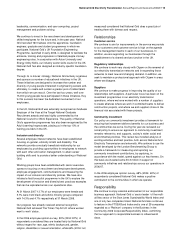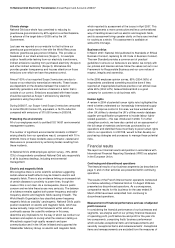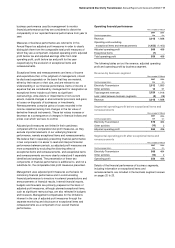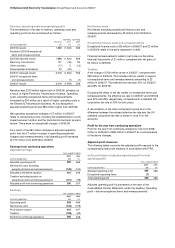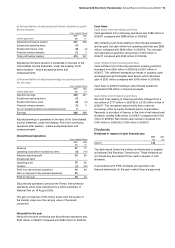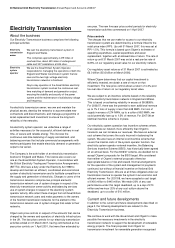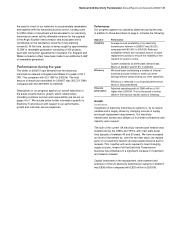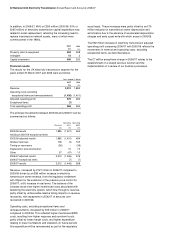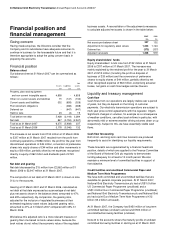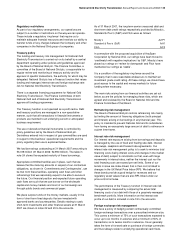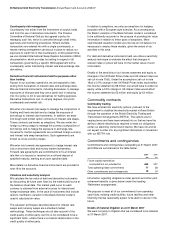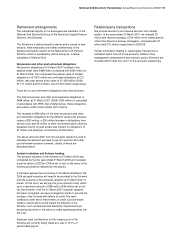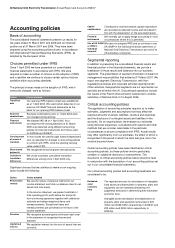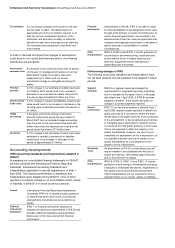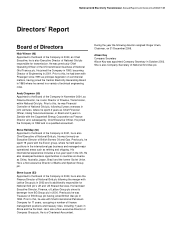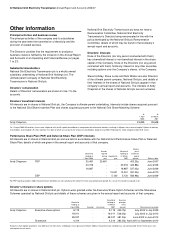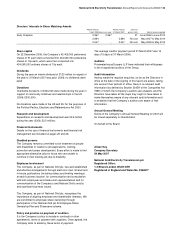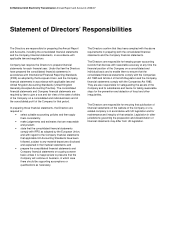National Grid 2007 Annual Report Download - page 27
Download and view the complete annual report
Please find page 27 of the 2007 National Grid annual report below. You can navigate through the pages in the report by either clicking on the pages listed below, or by using the keyword search tool below to find specific information within the annual report.
National Grid Electricity Transmission Annual Report and Accounts 2006/07 25
Regulatory restrictions
As part of our regulatory arrangements, our operations are
subject to a number of restrictions on the way we can operate.
These include a regulatory ‘ring-fence’ that require us to
maintain adequate financial resources and restricts our ability to
transfer funds or levy charges between the Company and other
companies in the National Grid group of companies.
Treasury policy
The funding and treasury risk management for National Grid
Electricity Transmission is carried out on its behalf by a central
department operating under policies and guidelines approved
by the Board of National Grid plc. The Finance Committee, a
committee of the Board of National Grid plc, is responsible for
regular review and monitoring of treasury activity and for
approval of specific transactions, the authority for which may be
delegated. National Grid plc has a Treasury function that raises
funding and manages interest rate and foreign exchange rate
risk for National Grid Electricity Transmission.
There is a separate financing programme for National Grid
Electricity Transmission. The Finance Committees of both
National Grid and of National Grid Electricity Transmission
approve all funding programmes.
The Treasury function is not operated as a profit centre. Debt
and treasury positions are managed in a non-speculative
manner, such that all transactions in financial instruments or
products are matched to an underlying current or anticipated
business requirement.
The use of derivative financial instruments is controlled by
policy guidelines set by the Board of National Grid plc.
Derivatives entered into in respect of gas commodities are used
in support of the business’ operational requirements and the
policy regarding their use is explained below.
We had borrowings outstanding at 31 March 2007 amounting to
£3,728 million (31 March 2006: £2,990 million). The table in
note 24 shows the expected maturity of these borrowings.
Appropriate committed facilities are in place, such that we
believe that the maturing amounts in respect of our contractual
obligations, as shown in ‘Commitments and Contingencies’, can
be met from these facilities, operating cash flows and other
refinancings that we reasonably expect to be able to secure in
the future. Our financial position and expected future operating
cash flows are such that we can borrow on the wholesale
capital and money markets and most of our borrowings are
through public bonds and commercial paper.
We place surplus funds on the money markets, usually in the
form of short-term fixed deposits that are invested with
approved banks and counterparties. Details relating to cash,
short-term investments and other financial assets at 31 March
2007 are shown in notes 22 and 23 to the accounts.
As of 31 March 2007, the long-term senior unsecured debt and
short-term debt credit ratings respectively provided by Moody’s,
Standard & Poor’s (S&P) and Fitch were as follows:
Moody’s A2/P1
Standard & Poor’s (S&P) A/A1
Fitch A/F2
In connection with the proposed acquisition of KeySpan
Corporation by National Grid, our ratings have been moved to
‘creditwatch with negative implications’ by S&P. Moody’s have
placed our ratings on ‘review for downgrade’ and Fitch have
maintained our ratings as ‘stable’.
It is a condition of the regulatory ring-fence around the
Company that it uses reasonable endeavours to maintain an
investment grade credit rating. At these ratings, we should have
good access to the capital and money markets for future
funding when necessary.
The main risks arising from our financial activities are set out
below, as are the policies for managing these risks, which are
agreed and reviewed by the Board of National Grid and the
Finance Committee of that Board.
Refinancing risk management
The Board of National Grid plc controls refinancing risk mainly
by limiting the amount of financing obligations (both principal
and interest) arising on borrowings in any financial year. This
policy is intended to prevent National Grid and its subsidiaries
from having an excessively large amount of debt to refinance in
a given time-frame.
Interest rate risk management
Our interest rate exposure arising from borrowings and deposits
is managed by the use of fixed and floating rate debt, interest
rate swaps, swaptions and forward rate agreements. Our
interest rate risk management policy is to seek to minimise total
financing costs (being interest costs and changes in the market
value of debt) subject to constraints so that, even with large
movements in interest rates, neither the interest cost nor the
total financing cost can exceed pre-set limits. Some of our
bonds in issue are index-linked, that is their cost is linked to
changes in the UK Retail Price Index (RPI). We believe that
these bonds provide a good hedge for revenues and our
regulatory asset values that are also RPI-linked under our
price control formulae.
The performance of the Treasury function in interest rate risk
management is measured by comparing the actual total
financing costs of our debt with those of a passively-managed
benchmark portfolio. More information on the interest rate
profile of our debt is included in note 19 to the accounts.
Foreign exchange risk management
We have a policy of hedging certain contractually committed
foreign exchange transactions over a prescribed minimum size.
This covers a minimum of 75% of such transactions expected to
occur up to six months in advance and a minimum of 50% of
transactions six to twelve months in advance. Cover generally
takes the form of forward sale or purchase of foreign currencies
and must always relate to underlying operational cash flows.


